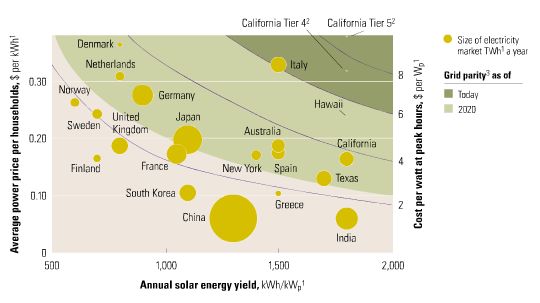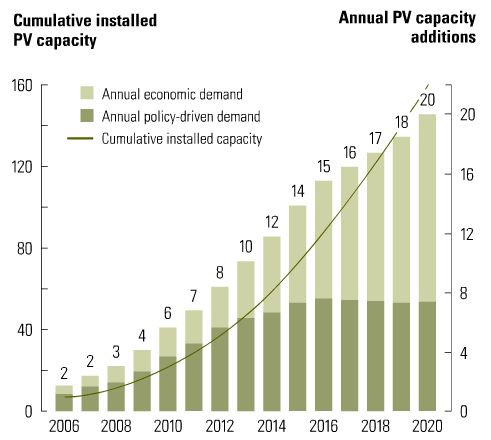McKinsey has a great new analysis piece: “The economics of solar power.” Overall it’s extremely optimistic, saying that despite uncertainties around technology and policy, growth in the solar sector is all but certain to be robust.
Here’s a interesting chart. The size of the yellow ball is the size of the solar market in TWh. The upper right of the chart is “grid parity” — i.e., solar electricity selling for roughly the same price as fossil electricity.
Notice that several large U.S. markets — California, Texas, New York — are expected to reach grid parity by 2020. Note, however, that China, with a much larger total market, will not, largely thanks to cheap and unregulated coal in that country. Steps by the Chinese government to price carbon or otherwise discourage coal could bump that yellow dot up and to the right.
Here’s another chart, showing the projected rise of solar PV installed capacity under fairly conservative “base-line” assumptions (including no breakthrough advances in thin-film, nanotubes, etc.):
A more aggressive scenario puts the 2020 capacity at well over double this number — 400GW. Note here the role of government support in kickstarting a market that will continue to expand long after policy supports are removed.
Interestingly, McKinsey is much more bullish on PV than on concentrated solar (CSP). They base their preference on the many opportunities for fundamental technological breakthroughs in PV that bring efficiency up and price down. CSP, on the other hand, intrinsically relies on steel, glass, and other commodities that are unlikely to substantially fall in price.
Despite all the optimism, this robust growth in solar will still yield a relatively small cumulative total:
Even if all of the forecast growth occurs, solar energy will represent only about 3 to 6 percent of installed electricity generation capacity, or 1.5 to 3 percent of output in 2020. While solar power can certainly help to satisfy the desire for more electricity and lower carbon emissions, it is just one piece of the puzzle.
Lots more, including advice for utilities, component manufacturers, and governments, in the analysis itself. Worth checking out.



